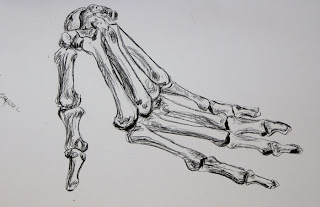Three Drawings
For the standing and a seated poses I did several two minute sketches and a couple of longer sketches before the main drawing. These were very helpful in giving me and idea of the basic proportions and shape of the forms. Oddly enough, (not really for me) in a couple of cases I think some of the sketches had more potential than the drawings.
 |
| pencil |
Check & Log
Did you try to imagine the sitter’s skeleton and muscles? Did this help you to convey the figure’s structure and form?
 |
| black art pen |
After the reading I did on anatomy, I was quite confident it had the effect of helping me to visualize the underlying skeleton and muscles when doing the drawings. It also gave me a better awareness of the exact locations of important joints – ankle, elbow, knee and hips and I felt that I could make more sense of and indicate the features on the surface, such as the elbows, knees and ankle joints on the sitting and standing poses. Having an idea that certain muscles form alternating masses pulling in opposite directions, such as those of the front of the thigh and the calf muscles of the lower leg helped me to notice and include their alternating curves with the standing and sitting poses. However I seemed to completely lose the effect in the calf muscle on show in the drawing of the lying down pose. I think because I was so conscious of the limited time on this occasion, plus I had already spent a lot of time on this one, struggling with the proportions.
How accurately did you depict the overall proportions of the figure?
I feel more relaxed if I sketch in some basic free flowing lines to indicate the gesture of the model before I start to concentrate on the proportions and angles of the head, shoulders and hips. Then start to fill in the basic forms starting with the head.
 |
| willow charcoal |
I spent a full hour on the drawings of the sitting and standing poses. The main areas of difficulty for me occurred on the lying down and sitting poses, due to the amount of foreshortening. Despite careful and repeated measurements in both I felt that certain areas like the head and feet were particularly awkward and didn’t look quite right when I had completed them. I understand that the head in the sitting pose should be larger than in the lying down pose because the model was sitting up so wasn’t as far back in space as when lying down and at the furthest point away. Where the model is sitting down the thighs are very foreshortened - infact the knees are almost level with the hips (pelvis), the effect being to visually squash some features down. Yet each time I look at the head it appears too big in relation to the length of the body, the shoulders look a little too wide. I’m not sure if the feet are too small, considering they are much closer than the head. In the lying down pose I feel that this time I have overly exaggerated the size of the feet - even though they are again very close on the picture plane and the head looks small in relation to most of the body.

Rembrandt’s Study of a Man (right) is another seated pose where the feet are nearest to the onlooker and they look larger than the feet in my seated pose. The upper body also looks fairly upright with a lot of foreshortening in the legs. The head only fits into the upper torso about 2.5 times – the same as the head in my own drawing of a seated pose. I also noticed how he has managed to indicate very convincingly the depression between the bones of the fingers on one hand and the hollow in the shoulder around the clavicle, with just a few deft strokes of the drawing tool.













